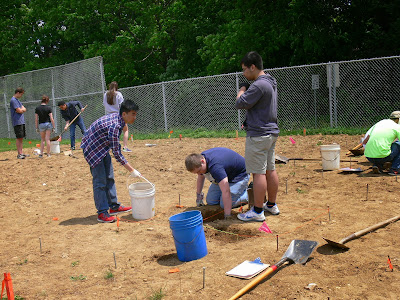On
May 18th, the Archaeology Section of the State Museum of
Pennsylvania began assisting Cedar Cliff High School with a three week simulated
archaeological project. As part of Mr. Daniel Reilly’s AP World History class, a number of students are spending part
of their day learning about and doing archaeology at a mock excavation near the
school’s sports stadium. For these students the program imparts a
multi-disciplinary learning experience they will be able to apply to other
classes in science and mathematics.
A
simulated archaeological excavation can be defined as an experimental project
organized by a classroom teacher that has an educational goal of reconstructing
human behavior using archaeological techniques (Chiarulli et al. 2000). Although students can learn about archaeology and
archaeological methods in a classroom setting, there is nothing like a hands-on
experience through a simulated excavation.
Mr.
Reilly (assisted by several other teachers who were intrigued with the project)
created a multi-component site; that is, one dating to both historic
Euroamerican times and one dating to a Native American occupation prior to the
arrival of the Europeans, by burying artifacts in the ground. The artifacts representing
the Native American camp site included a fire-cracked-rock hearth or oven with
charcoal and food remains situated next to a pile of flakes from the production
of stone tools (debris created by an actual flint knapping demonstration). In
the corner of the site, three burials were placed; not actual human remains,
but deer skeletons aligned in a human-like fashion – thus creating the “deer
people”! The Euroamerican site was comprised of a brick fireplace with charcoal,
broken dishes and food remains. Mr. Reilly registered the site with the
Pennsylvania Archaeological Site Survey and was assigned the number 36CU0210.
In
preparation of fieldwork, the students were taught the difference between
archaeology and paleontology; that archaeology is a subfield of anthropology –
the study of human cultures; the nature and significance of stratigraphy; and
the importance of archaeological context or the location of the site and the
three dimensional location of the artifacts within it.
Mr.
Reilly holds a Masters degree in Archaeology from Queen’s University of Belfast
in Northern Ireland where he has excavated Bronze Age, Iron Age, and Medieval
sites. He also spent four years conducting
compliance archaeology in the Middle Atlantic region before becoming a teacher.
Working with limited resources, Mr. Reily was provided with basic field
equipment (shovels, buckets, tapes and screens) from The State Museum of
Pennsylvania, Section of Archaeology.
The
students conducted a controlled surface collection across the site, and placed
flags where artifacts were found. This was followed laying out the excavation
grid and a lesson on the Topcon total station (a laser based electronic transit
and data recorder) from State Museum staff. Archaeology stresses precise
mapping in order to identify patterns in artifact distribution.
students begin excavation in their chosen 1m x 1m units
Based
on the results of the controlled surface collection, the students broke into
teams and selected a one meter unit for excavation. Using the principles of the
Pythagorean Theorem (A squared + B squared = C squared), they placed stakes at
the corner of their squares, connected them with string and started excavating.
The plowzone was removed with shovels and the soil screened through a ¼ inch mesh.
The students were taught that the context of artifacts in the plowzone had been
compromised, and as a consequence, were not mapped with the same precision as
those found at deeper, undisturbed soil layers. Once the subsoil was uncovered
they began to dig more carefully with trowels.
Each team was responsible for taking detailed field
notes to document the location of features and the artifacts found in them. In
the lab, the artifacts will be examined and a report developed that documents
the methods and the findings. The students enjoy finding “stuff”, but they will
also enjoy weaving the story of how the artifacts ended up at the site. Each
student’s excavation report will include a review of excavation methodology, an
analysis of recovered artifacts, conclusions drawn about each “culture” based
on that analysis, and a recommendation for further work at 36CU0210.
Archaeology
is a multidisciplinary study encompassing aspects of geology, biology,
mathematics, history and anthropology. Simulated archaeological projects can be
a learning and entertaining experience for the students where they use
archaeological data in a holistic approach to develop critical thinking skills
with an emphasis on behavior rather than artifacts.
Participation
in this project and other outreach programs provides an opportunity for staff
at the State Museum to educate the public in understanding archaeological
methods, and clarifies some misconceptions about how archaeology is conducted. In
summary, an archaeological field experience for high school students such as
this allows teachers to answer the age old question often asked by students –
“Why do we have to know this stuff?” This project helps students how other
disciplines tie into creating the ‘big picture’ and allows them to understand
why all learning is important.
Bibliography
Chiarulli, Beverly A., Ellen Dailey
Bedell and Ceil Leeper Strudevant
2000 Simulated
Excavations and Critical Thinking Skills. In The Archaeology Education Handbook, edited by Karolyn Smardz and
Shelley J. Smith. pp.217-233, Altamira Press.










